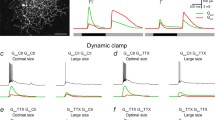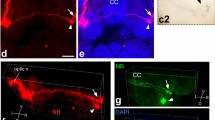Summary
-
1.
The lateral visual (LV) cells of the medicinal leech,Hirudo medicinalis, are excited by photoreceptors having axons in the ipsilateral DC and DD nerves. Activating the photoreceptors photically or electrically yields at least three kinds of event in the LV cell (Fig. 1B).
-
2.
There are very small events, which appear to be electrical coupling potentials from the photoreceptors (Fig. 6); there are large events, which appear to be action potentials arising in the main neurite and propagating out the axon (Figs. 2, 5); and finally, there are unusual medium-sized events.
-
3.
These medium-sized events appear to be ‘stacks’ of several small spike-like components (Fig. 7A). These small spikes have different thresholds and latencies, suggesting that they arise at different initiation sites (Fig. 7B).
-
4.
Small spikes are not chemical excitatory postsynaptic potentials (EPSPs), since they persist in high Mg saline (Fig. 7). They are not antidromic impulses arising distally in the axon, since they do not collide with orthodromic action potentials (Fig. 8). Nor, given the initiation kinetics of small spikes, are they coupling potentials from neurons having axons in the optic nerves (Figs. 11, 12).
-
5.
Moderate hyperpolarization increases the amplitude of small spikes, but strong hyperpolarization blocks them (Fig. 9). Very strong hyperpolarizing pulses elicit small spikes by anode break excitation (Fig. 10).
-
6.
These results suggest that small spikes may be active responses that arise locally in the dendrites of the LV cell but fail to propagate actively into the main neurite and axon (Fig. 16).
-
7.
Alternatively, small spikes may be coupling potentials from unidentified interneurons that are strongly electrically coupled to the LV cell. In order to account for the results, however, there would have to be at least 24 such interneurons. The failure to find any coupling neurons, despite extensive searching, makes this alternative possibility increasingly unlikely.
-
8.
The small spikes activated by axons in the DC nerve appear to be distinct from those activated by axons in the DD nerve (Figs. 13, 14).
-
9.
Within the main neurite the small spikes behave like conventional EPSPs: they sum temporally and spatially, and they interact with inhibitory synaptic input to set the firing level of the LV cell (Figs. 12A, 15).
-
10.
Thus, there appear to be two stages of integration in the activation of the LV cell: at the first stage, EPSPs from the photoreceptors sum to elicit small spikes; at the second stage, the small spikes sum to generate action potentials.
Similar content being viewed by others
Abbreviations
- LV :
-
lateral visual (cell)
References
Calabrese RL, Kennedy D (1974) Multiple sites of spike initiation in a single dendritic system. Brain Res 82:316–321
Diamond J (1971) The Mauthner cell. In: Hoar WS, Randall DJ (eds) Fish physiology, vol 5. Academic Press, New York, pp 265–346
Dodge FA (1979) The nonuniform excitability of central neurons as exemplified by a model of the spinal motoneuron. In: Schmitt FO, Worden FG (eds) The neurosciences: Fourth Study Program. MIT Press, Cambridge, Mass., pp 439–455
Eccles JC (1957) The physiology of nerve cells. The Johns Hopkins Press, Baltimore
Erlanger J, Gasser HS (1937) Electrical signs of nervous activity. Univ of Pennsylvania Press, Philadelphia
Hagiwara S, Byerly L (1981) Calcium channel. Annu Rev Neurosci 4:69–125
Kramer AP, Krasne FB, Wine JJ (1981) Interneurons between giant axons and motoneurons in crayfish escape circuitry. J Neurophysiol 45:550–573
Llinás R, Nicholson C (1971) Electrophysiological properties of dendrites and somata in alligator Purkinje cells. J Neurophysiol 34:534–551
Llinás R, Sugimori M (1980a) Electrophysiological properties of in vitro Purkinje cell somata in mammalian cerebellar slices. J Physiol (Lond) 305:171–195
Llinás R, Sugimori M (1980b) Electrophysiological properties of in vitro Purkinje cell dendrites in mammalian cerebellar slices. J Physiol (Lond) 305:197–213
Matsumoto SG, Hildebrand JG (1981) Olfactory mechanisms in the mothManduca sexta: response characteristics and morphology of central neurons in the antennal lobes. Proc R Soc Lond B 213:249–277
Muller KJ, McMahon UJ (1976) The shapes of sensory and motor neurones and the distribution of their synapses in ganglia of the leech: a study using intracellular injection of horseradish peroxidase. Proc R Soc Lond B 194:481–499
Muller KJ, Nicholls JG, Stent GS (1981) The neurobiology of the leech. Cold Spring Harbor Laboratory, Cold Spring Harbor, NY
Nicholls JG, Purves D (1970) Monosynaptic chemical and electrical connexions between sensory and motor cells in the central nervous system of the leech. J Physiol (Lond) 209:647–667
Pellionisz A (1979) Modeling of neurons and neuronal networks. In: Schmitt FO, Worden FG (eds) The neurosciences: Fourth study program. MIT Press, Cambridge, Mass., pp 525–546
Peterson EL (1983) Visual processing in the central nervous system of the leech. Nature 303:240–242
Peterson EL (1984) Photoreceptors and visual interneurons in the medicinal leech. J Neurobiol (in press)
Roberts A, Krasne FB, Hagiwara G, Wine JJ, Kramer AP (1982) Segmental giant: evidence for a driver neuron interposed between command and motor neurons in the central escape system. J Neurophysiol 47:761–781
Schwartzkroin PA (1977) Further characteristics of hippocampal cells in vitro. Brain Res 128:53–68
Schwartzkroin PA, Slawsky M (1977) Probable calcium spikes in hippocampal neurons. Brain Res 135:157–161
Sigvardt KA, Hagiwara G, Wine JJ (1982) Mechanosensory integration in the crayfish abdominal nervous system: structural and physiological differences between interneurons with single and multiple spike initiating sites. J Comp Physiol 148:143–157
Spencer WA, Kandel ER (1961) Electrophysiology of hippocampal neurons. IV. Fast prepotentials. J Neurophysiol 24:272–285
Traub RD, Llinás R (1979) Hippocampal pyramidal cells: significance of dendritic ionic conductances for neuronal function and epileptogenesis. J Neurophysiol 42:476–496
Van Essen DC (1973) The contribution of membrane hyperpolarization to adaptation and conduction block in sensory neurones of the leech. J Physiol (Lond) 230:509–534
Zucker RS (1972) Crayfish escape behavior and central synapses. III. Electrical junctions and dendrite spikes in fast flexor motoneurons. J Neurophysiol 35:638–651
Author information
Authors and Affiliations
Rights and permissions
About this article
Cite this article
Peterson, E.L. Two stages of integration in a leech visual interneuron. J. Comp. Physiol. 155, 543–557 (1984). https://doi.org/10.1007/BF00611918
Accepted:
Issue Date:
DOI: https://doi.org/10.1007/BF00611918




